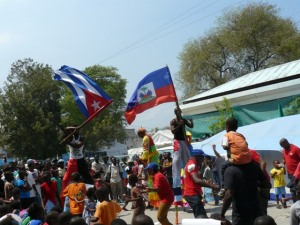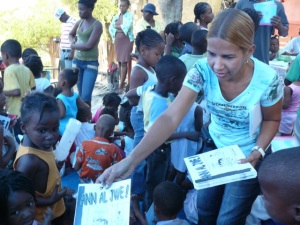Cuban Artists Bring Joy to Haiti

HAVANA TIMES, March 26 — A brigade of Cuban visual and performing artists have been in Haiti as a cultural complement to the island’s on-going health care assistance in the neighboring Caribbean island country. Conner Gorry is writing a blog from Haiti for mediccglobal and here is her latest entry.
LOVE, LAUGHTER & ART IN POST-QUAKE HAITI
By Conner Gorry
HAVANA TIMES, March 26 — “Where there’s love, there’s life,” said Gandhi and Port-au-Prince has been overflowing with both since the arrival of the Martha Machado Artists’ Brigade here in Port-au-Prince. The brainchild of Cuban artist Alexis Leyva Machado (Kcho–pronounced KAHcho) the artists’ group aims to alleviate the psychological and emotional effects of natural disasters. Watching children’s beaming smiles and hearing squeals of delight peal from teens and adults alike as the group performs, I’d say it’s working.
Founded after a trio of hurricanes hit Cuba in 2008 causing $10 billion in damages, the Brigade features a rotating roster of painters, musicians, magicians, clowns, puppeteers, and circus performers.
Fifty of these Cuban artists are now in Haiti to help heal through laughter, dance, art, and play; many are veterans of the original Brigade that visited the Cuban provinces hardest hit by the 2008 hurricanes. One of those provinces was the special municipality of Isla de Juventud (Isle of Youth), from where Kcho hails. The Brigade is named after the artist’s mother who gave shelter to family, friends, and neighbors affected by the storms.

The healing properties of laughter and play are well documented and serve particularly well for children in post-disaster situations. Young survivors are often unable to express the resulting trauma verbally, complicating mental health diagnoses and the work of health care professionals.
For this reason, the Martha Machado Brigade is formally a part of Cuba’s post-disaster mental health program in Haiti, coordinated by psychologist Alexis Lorenzo of the Latin American Center for Disaster Medicine (CLAMED) in Havana. “Much of what we’re seeing are normal reactions to abnormal circumstances,” he told me, including anxiety, fear, stress, and sadness – a trio that gets blown to the four cardinal points when people become engaged with the Cuban artists in their midst.
“The situation is so sad here, but you can feel the energy shift when the Brigade shows up. The kids enter a new world,” artist Ernesto Rancaño told me as we watched an event unfold at the Renaissance Hospital. A magic trick deftly executed; stilt walkers rocking babies and clowns kidding teens; a Cuban artist and Haitian child painting side by side–these are the building blocks of happier memories for Haitians traumatized by the January 12 earthquake. The more the children can express their feelings the better, according to psychologists, since drawing and other types of creativity help them gain symbolic control over confusing and frightening events.
One of Cuba’s most talented contemporary painters and original member of the group in Cuba, Rancaño and several other painters supplied all the materials for the post-hurricane work in Cuba, creating alongside Cuban children affected by the storms.
This experience is being replicated in Haiti; the resulting works of art by Haitian children, together with over a dozen paintings by Cuban children brought by the Brigade for this purpose, will be installed in public hospitals in Haiti. Twenty five works of art by Kcho, Rancaño, Sander Gonzales, and Juan Carlos Balseiro will likewise be permanently installed in Haitian hospitals. All told, the collection comprises over 150 works of art.

“This goes beyond Cuba, beyond Haiti. Our mission is to bring smiles and hope to people who have suffered natural disasters. The healing power of art and laughter are universal and this is what our Brigade tries to do,” said Kcho later at an event at the Cuban field hospital in Carre Foure west of Port-au-Prince. The group of artists has pledged to stay as long as necessary.
Still made up as clown and musician, Ronny Fernández from Havana told me why he joined the team in Haiti: “It’s beautiful to be able to use our skills to take these people away from the catastrophe, if only for a moment…. We’re living in tents and conditions can be tough, but the smiles on the kids faces–that’s plenty compensation.”
Combining caring and science is part of psychologist Diaz´s work, including a methodological framework for addressing disaster-related mental health disorders. As coordinator of CLAMED’s master’s degree program in Mental Health and Disasters, Diaz is accompanied in Haiti by the two-year program’s first graduate. Also in Haiti to address the mental health needs of earthquake survivors are four psychologists, 12 child psychiatrists, and 7 general psychiatrists.
Psychologist Mariela Almenares is among these Cuban volunteers working with Haitian children and teens who survived the quake. In an initiative launched on March 17, Mariela leads a team comprised of Argentine and Haitian doctors and 5th year students trained at Havana’s Latin American Medical School.
They are providing integrated medical and psychological services to several orphanages in Port-au-Prince, where the Artists´ Brigade also performs. All agree this is one of their hardest assignments. “Yet, ten years down the line, hopefully these kids will remember today and have at least this one good memory from this terrible tragedy,” Rancaño told me. I’m betting he’s right.






This is such a wonderful and inspirational article.